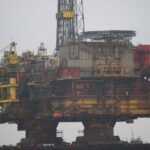Oil is a critical source of energy in the United States. Crude oil, extracted directly from underground reservoirs, is the basis of all petroleum products such as gasoline and diesel. As of 2021, Americans consume 18,684,000 barrels daily.
Skyrocketing oil prices in the wake of the pandemic, coupled with import bans on Russian barrels, have caused efforts to shift energy reliance onto more renewable forms. Even with growing alternative energy sectors oil remains a principal resource within the domestic economy and abroad.
To transport this resource a vast system of pipelines spans the United States, covering thousands of miles. These pipelines remain the safest, most efficient way to transport oil.
The construction of new oil pipelines remains a controversial subject. The argument stands that the expansion of the pipeline system is necessary for increasing energy demand, as well as to decrease reliance on foreign nations’ oil exports. On the contrary, new pipelines carry the risk of environmental degradation.
However, there are ways of alleviating negative environmental impacts as a result of new pipelines. Emerging technologies in the industry, such as drone-based inspections and the use of specially coated materials in pipeline construction to prevent leaks, have been instrumental in minimizing harm to the ecosystems pipelines run through.
Innovative strides in the field of environmental engineering continue to lessen the impact of construction on the environment while ensuring America’s energy needs are met. In this article, we’ll be diving deeper into the pipelines that currently exist in the United States.
How Many Oil Pipelines Are in the United States?

via Pixabay
As of 2020, there were 182 oil pipelines either active or under construction in the United States. This number is more than double the amount that Russia—the nation with the second-most amount of oil pipelines—has, as that country boasts only 61 established lines.
In America, pipelines operate 24 hours a day, 7 days a week. About 42% of domestic crude oil comes from Texas. This includes barrels from the Gulf of Mexico offshore, the second-largest oil-producing territory following Texas.
The offshore territory stretches along the entirety of Texas’s eastern coast to Florida’s southern tip. The second-most oil-rich state, New Mexico, only accounts for 11% of the U.S.’s oil share.
This number only accounts for oil pipelines, as opposed to natural gas pipelines. There are many more natural gas pipelines spanning the nation, however, they are fundamentally different from oil pipelines. Natural gas lines can carry more fuel as natural gas is far more compressible than crude oil.
In addition, crude oil pipelines require additional heat to prevent blockages. The environmental consequences of oil pipelines are more drastic, as any leak may catch fire easily and quickly become an emergency. As a result, oil pipelines undergo frequent maintenance, as well as constant supervision from remote operating rooms.
Even in the case of high-magnitude earthquakes pipelines remain safe, as operators in these control rooms can close down isolated segments of lines in case of a disaster.

via Pixabay
The introduction of modern technology has been revolutionary in the oil industry. Remote control rooms often employ AI (artificial intelligence) to properly detect leaks before they happen, and automation ensures safety. Additionally, the use of drones is becoming increasingly popular in the industry.
These devices are often used to conduct aerial surveys, necessary to document changes in the field above a pipeline. They can gain entry to confined spaces previously inaccessible.
Offshore inspections, a dangerous task once performed by human inspectors, are much more efficient with the use of drones. With drones’ obvious advantages in safety and efficiency, their use among oil companies is likely to grow much larger in the near future.
How Many Active Oil Pipelines Are in the U.S.?
Of the 182 pipelines in the U.S., only 160 of them are active. These 160 pipelines transport both crude and refined oil. To transform crude oil into refined products like gas or diesel crude oil must first be transported to a refinery.
These refineries are scattered across the U.S., with many clustered on the shores of the Gulf of Mexico. Jobs related to refining and other sectors of the oil industry are important sources of employment in oil-rich states.
As a result, states like North Dakota, even though it is the third-most oil-productive state, has one of the lowest unemployment rates in the nation. Nationally the oil and gas industry contributes to nearly 8% of the United States GDP.
Although there are thousands of miles of active pipelines, there are many more miles of decommissioned or abandoned pipelines. Decommissioning a pipeline is a costly procedure. Strict federal policies maintain that the pipes must be flushed of all hazardous waste before being disconnected from the line as a minimum requirement.
Sometimes removing the pipeline altogether is necessary. This is more common among above-ground pipes to allow for refurbishment and reuse of the land. More costly, dangerous, and environmentally disruptive processes of removing pipelines are often avoided at all costs.
Does the U.S. Have Enough Pipelines?
The U.S. has the most crude oil pipelines in the world as well as being the top oil producer in the world as of 2022 so, yes, it does have enough pipelines. However, roughly 50% of oil pipeline space sits unused. Before the global COVID-19 pandemic, between 60% and 70% of these pipes were utilized, with many more lines being constructed to fuel a production boom.
That global health crisis caused the demand for oil and gas to plummet, and production followed suit. Even with demand surging back to pre-pandemic levels, oil companies have been slow to recover their losses. Properly maintaining pipelines is an expensive pursuit and one that many companies in the industry were not equipped for.
Currently, gas prices are on the rise, and the war in Ukraine has shifted demand to domestic gas companies. A new focus on environmental policy within the current presidential administration makes new pipeline construction especially difficult.
Permits to construct pipelines are more difficult to obtain than ever, and complying with environmental restrictions makes the construction process especially expensive. Thus, 2022 saw a decline of 13.4% in oil pipeline construction, with an even sharper decrease expected in 2023. Oil pipeline construction in 2023 is much more economically viable than it once was.
Domestically, the U.S. does not have a demonstrated need for new oil pipelines. New construction would not necessarily lower gas costs, nor would it have a significant impact on oil production. With only 50% of standing pipelines in use, there is no immediate demand for increased capacity.
Current pipelines require constant refurbishment and care, however, and future demand for more extensive pipeline construction may arise.
Do We Import More Oil Than We Export?
In 2021, the United States exported more petroleum than it imported. Petroleum refers to refined oil and includes substances such as gasoline, distillate, and jet fuel. Still, the country remained a net crude oil importer in 2021, meaning it imported more crude oil than it exported.
When analyzing the oil market, it is important to note that crude oil comes in varying degrees of quality, each with different prices associated with their refinement. Due to these factors, sometimes importing oil is the more economical option.
A common argument among those advocating for extensive pipeline construction is that it would allow the U.S. to establish self-sufficiency in oil. However, many also believe that self-sufficiency would not result in reduced prices.
The oil market is global, not confined to national boundary lines. U.S. producers would continue selling oil at the internationally set price, rather than selling for a loss to American consumers.
Allowing U.S. oil to traverse the global market is the best option for American companies as well as consumers. While we import slightly more oil than we export, it turns out that this may not be a bad thing.
Why Does the U.S. Import Oil When We Already Have Oil?

via Pixabay
In simple terms, the U.S. imports oil because the consumption of oil products per day outweighs the daily production of the substance. Additionally, foreign oil is often much cheaper than the domestic product.
Considering the initial quality of the oil, how and where it is refined, as well as transportation costs, it is often more economical to simply import the product. The U.S. produces enough oil to meet the population’s needs, but it is the wrong type of oil.
Most American refineries are more suited to forms of oil from regions like the Middle East and Russia. To adapt these standing refineries to American oil would be a lengthy, as well as costly, process.
Oil importation and sanctions are often important political tools. It may form the basis of important international alliances and institutions such as OPEC.
The resource is so vital for nearly every country participating in the international oil market, especially as a primary exporter, which grants a lot of power and wealth. It is beneficial for the U.S. to continue importing oil, both economically and politically.
Final Thoughts
The vast pipeline system spanning the nation is essential for transporting such a crucial source of energy. Making up as much as 8% of the country’s GDP, the oil and gas industry is invaluable in maintaining and growing the economic strength of the nation.
Through both the exportation and importation of oil, the United States remains an economically strong nation. The introduction of new technologies, such as drones, allows for much safer oil transportation practices.
With the help of environmental engineers, the industry is steering toward more ecological practices. Oil pipelines remain the most efficient and environmentally friendly way to transport the resource and will likely remain so for the foreseeable future.





